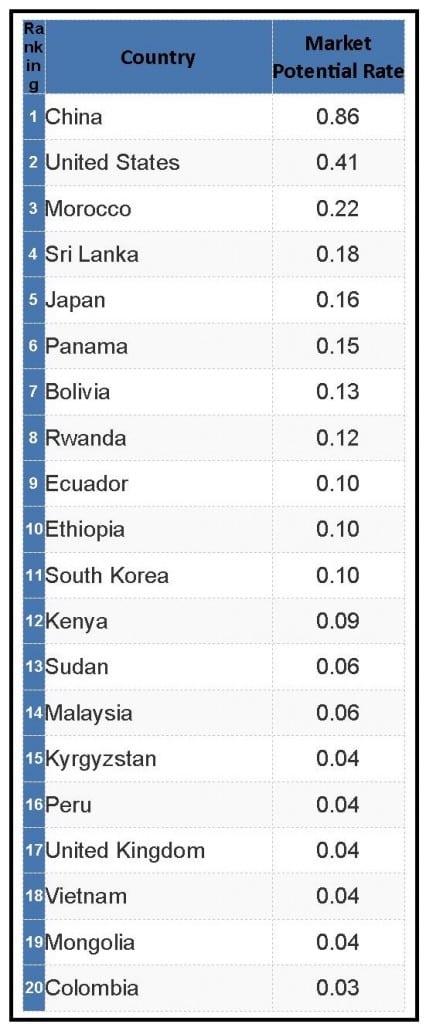I got a nasty shock the other day, perusing a global tea report.
Well, not the actual report, because access to that is over $19,500 and that seems pretty steep.
But a report on the report. Here it is, if you want to check it out yourself. It’s less funny than my round-up, though.
72 countries were analysed as to how much of an increase in overall tea consumption was predicted. And here’s the top 20.
Who’s missing from this list? Australia, that’s who!
Yes, 72 countries, including Australia, were analysed, and the growth rate for each calculated.
I’m going to assume these guys got it right. After all, they are charging $19,500+ for the report, and you can’t do that unless you are damn clever, right?
In Australia, we see virtually everything as a sport, and I must say, I’m not happy to have not made the Top 20. Not just because we happen sell tea in Australia- oh, no. It’s a matter of national pride.
So, let’s take a good hard look at the list and see if there is any funny business going on.
First up, China. First reaction: China? What? They are already awash with tea.
However, they have a fast growing economy and a faster growing middle class. My guess is that previously exported tea may now be more affordable for local consumption.
Next, the United States. Having watched our own sales grow there, and seeing how hot and trendy tea is becoming there first hand, I can see that this is fairly obvious. Way to go, USA!
Morocco’s intriguing. Most tea there is drunk mixed with mint, their economy is not great, I wonder what’s going on? Perhaps just a shift into exploration of other teas.
Sri Lanka is gradually becoming more prosperous, so I guess more tea can be afforded. Japan is not, so I guess drinking tea helps pass the time.
Panama. Panama? PANAMA???
What is the world is Panama doing in this list? I searched “Tea Culture in Panama” and got 2 articles about a coffee and food tour in Panama City, a link to Wikipedia’s entry for Hibiscus ‘tea’, and Facebook page for a tea shop in Panama City managed by someone with the not very Panamanian name of David Hayes. Number five was “Childbearing the Panamanian Way.
Nevertheless, I have a theory: one of the aforementioned Mr Hayes’ customers reviewed their iced green tea and loved it. If that person had 2000 cups last year, and indicated that they might have 2003 this year, then there’s your .15% Go for it, Kris Tiger, your country needs you!
Having dismissed Panama thusly, I think I can pretty well place the next entry – Bolivia – as well as their other continental neighbours Ecuador, Peru and Columbia into the same basket.
Rwanda is next up, and that’s not surprising. It’s a country that is making good strides in quality tea production, and so I hope they do enjoy more of it.
Next I want to discuss New Zealand. They are NOT on the list. GOOD! There’s nothing worse than when those guys do better than us. Thankfully, it’s rare.
I’m going to group a country known for producing primarily poor quality tea for teab*gs – Kenya – with one known primarily for drinking poor quality tea from teab*gs – The UK – and say I just don’t care. Shouldn’t even count, in my opinion.
South Korea is really gaining in terms of world acceptance of their teas, I’m not surprised this might lead to a boost in tea drinking in-country.
Sudan, Malaysia, Vietnam, Mongolia between them average 0.05. I’ll ignore them.
That only leaves Kyrgyzstan. Is that actually a place? If it was a person, it would be a character in a murder mystery, in a scene that involves this dialogue:
“Hello, Kyrgyzstan. Or should I say….” *Rips off mask… etc
And of Australia, not a mention.
This bit is exclusively for other Australians: Perhaps we’re number 21. Perhaps we are only a few purchases away from making the list. Perhaps, my fellow Australians, if you’d spent a bit less time drinking coffee and/or stale grape juice and bought just a bag or two more from The Devotea’s Australian On-line tea store, we could have made that list. How about that, hey? Don’t you feel you’ve let the side down? Don’t you feel unAustralian right now?
An interesting stat from the report is this:
Currently, green tea (unfermented) accounts for 43.2% of the global demand while the remaining market share is divided between black tea (fermented or partly fermented) (29.8%) and tea concentrates, extracts and essences (27.0%).
So, even by grouping black and oolong together as black, green tea is well ahead. I think they’ve grouped whites into green.
My favourite kind if tea is not top of the list. My country is not even on the list.
So, I’d best turn to cricket if I want to rejoice in Australia being number one in the world.
As for tea market growth, there’s nothing left to do but look forward to next year’s report. And drink plenty of tea while I wait.
Because I’ll be doing my patriotic bit, and increasing my consumption … for my country.
Comments
2 responses to “Kyrgyzstan? Peru? I Weep for my Country”
May I doubt these results?
There is something strange with these figures.
[…] dear fellow Teatrader @thedevotea wrote a few weeks ago a post on a report about the increase in tea consumption in the world between now and 2019. His main […]